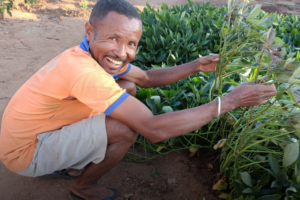Looking beyond emergency aid toward a brighter nutritional future
In Karamoja, in the north of Uganda, a pastoralist population is turning its hand to cultivating orange-fleshed sweetpotato. Poverty rates are high in this dry, fragile environment where acacia trees dot the flat savannah grasslands and people still die of malnutrition.
“The pastoralists have never shown much interest in cultivating crops apart from sorghum, but the changing climate and an increase in cattle rustling mean that they are looking for other options,” says Dr Norman Kwikiriza, Monitoring Learning and Evaluation Specialist at CIP – Uganda. “The orange-fleshed sweetpotato is perfect for them. It grows much faster than other crops, even during droughts when nothing else does and you can also eat the leaves which are nutritious.”
CIP has distributed more than 30 million biofortified orange-fleshed sweetpotato cuttings across northern Uganda, supported by a nutrition education outreach program reaching over 100,0000 households. Schools act as community change agents, providing land for sweetpotato root and vine production, which the children take home to plant.
“This helps both refugee populations and the host communities who have limited resources and who are coming under increased pressure from the new arrivals in terms of their food security”
“Sweetpotato is providing a lifeline for people who live in really challenging conditions that are just getting harder,” says Henry Turinawe, a nutritionist from the Lutheran World Federation (LWF), a CIP partner that is helping reach the most vulnerable populations. “It provides nutrition, and in some cases, income, empowering people to grow their own food and not have to rely on humanitarian aid beyond the immediate crisis.”
A case in point is ongoing work to implement nutrition and livelihood programs in Moyo, Obongi, and Adjumani displaced and host communities. These are the safe havens for refugees fleeing conflict in South Sudan. So far, 700,000 cuttings have been distributed to 2,400 refugee and host communities households.
“The refugees are given small plots of land when they are settled in the country where they plant sweetpotato,” says Paul Lubolo from LWF. “This helps both refugee populations and the host communities who have limited resources and who are coming under increased pressure from the new arrivals in terms of their food security.”
Beyond the lab – breeders go the extra mile to meet the end users and their needs
“For the Vitamin A-rich biofortified orange-fleshed sweetpotato to be integrated into the target communities in the longer-term, it is essential that we as breeders listen to what the farmers and communities want,” says Hugo Campos, CIP Deputy Director General for Research, CIP. “In Uganda, adoption rates of resilient sweetpotato varieties released through breeding programs have been low, so we talked to more than 1,300 people, including farmers, traders, seed producers, and consumers, to find out what drives choices as part of work to shortlist varieties in our pipeline.”
After trials in five agroecological zones, three shortlisted varieties were planted in farmers’ fields. Farmers and target communities got to work alongside researchers to rank agronomic traits like yield and resilience and consumer traits like taste, texture, and aroma.
“We went to the communities to cook the shortlisted varieties in traditional recipes,” says Reuben Ssali, Breeder, CIP Uganda. “We did not just ask the farmers about what drives their seed buying decisions, we went with them to seed suppliers. We accompanied women to the market to find out first-hand what they buy and why – up to 65 % of producers are women so they are influential in variety adoption. We found out that traits we may overlook can matter such as a highly fibrous texture– no one wants to eat a sweetpotato that gets stuck in your teeth!”





